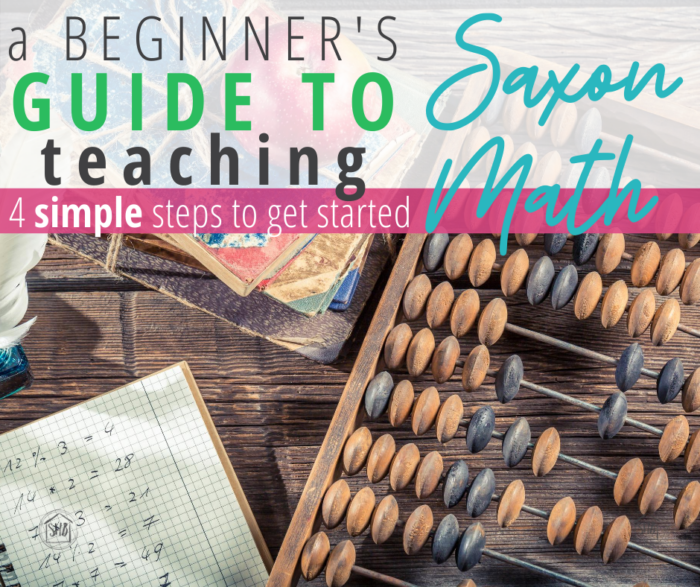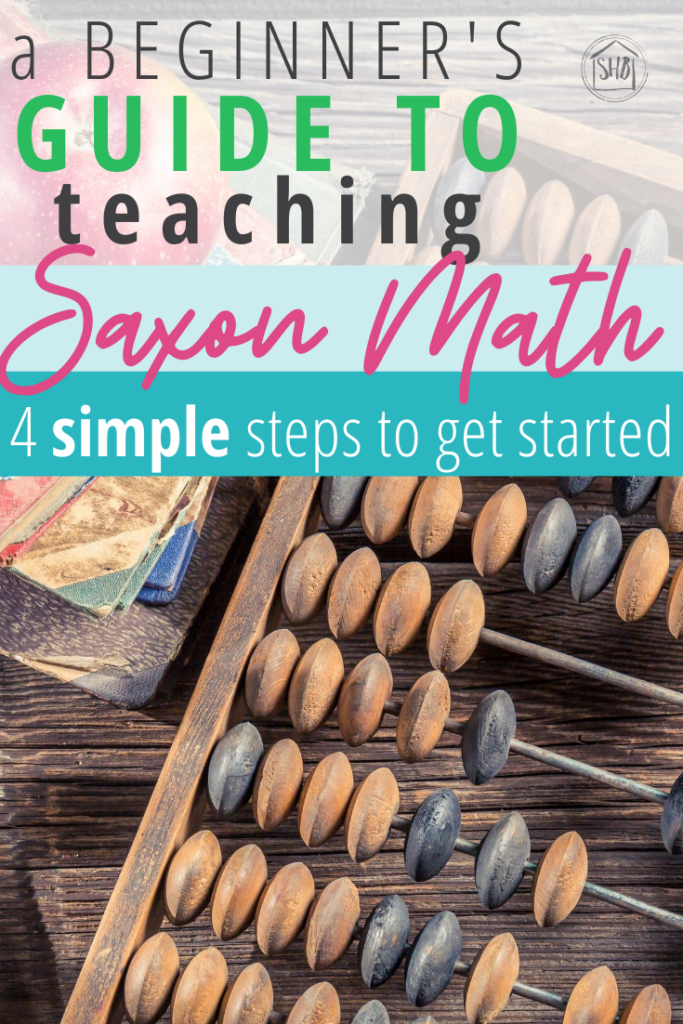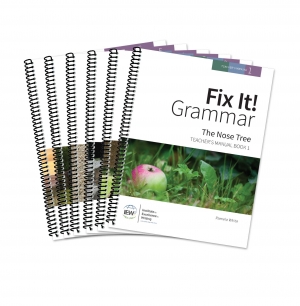
Whew. I just spent the last hour putting together our Math for this year. We have 2 students going through two of the early years Saxon – 1 and 2. This is the 4th year I will have taught Saxon Math for the early years. In previous years, I have discovered that the biggest hurdle in teaching Saxon Math is not instruction. It is preparation.
Don’t let that scare you. I have a bunch of very specific tips for making the prep and teaching of Saxon Math in the early years here for you. Get ready to teach without spending hours of prep. Are you ready?
This post may include affiliate links. If you click and make a purchase based on my recommendation, I get a small remuneration at no extra expense to you. I only recommend things I use and believe to be a blessing.
Before You Buy
Please, please, if you get no other information from this post, take this away: have your student take the Placement Test. It takes just a few minutes. You can avoid the frustration of a wrongly placed student. Too easy, too hard – frustrations can be avoided simply by taking the placement test.
I speak as a parent/teacher who truly should have given the Placement Test to my second student. I simply assigned her Math 1 because she was in 1st grade. It was way too easy for her, all the way through. We had to come up with other solutions to get her back “on track.”
Do not give the placement test at the end of the year of math. Do not give the placement test after starting – it is too late.
What You Need
There a a couple of versions of Saxon available. When I talk about Saxon, I am talking about the Homeschool editions. They are the currently available ones. I do not purchase older versions or intermediate versions.
For the early years you will need:
- the Teacher’s Edition
- a Morning Meeting book – different for each level
- the Student Work Kit
- a Manipulatives Kit (purchase once, use forever)
If you are repeating a level (with another student), you will only need the meeting book and the student work kit.
You may read other parents discuss not getting some of these things (like the meeting book and the manipulatives). I have purchased each of these things and have found value in them with each student. The manipulatives also help to keep my younger kids occupied whilst I am teaching the older kids. They LOVE to play with the pattern blocks, linking cubes, and counting bears.
Psst…I have written about my epiphanies regarding the morning meeting here, if you are interested in more about the “why” of the morning meeting.
Unpacking and Preparing for the Year
Once you have all your supplies, you will want to take a little bit of time at the beginning of the year to create the systems you will use each day you do Saxon Math. Here’s what I did to prepare Year 1 and Year 2 – same process for each level.
Open Student Work Kit
Inside the Student Work Kit you will find two booklets with worksheets. These are perforated at the top, so you can leave them in the booklets, or you can go ahead and tear them out.
I tear out the first book and leave the second one in tact (to be opened mid-year). I put these into a 3″ 3-ring binder – I prefer the ones with a slanted ring, so the papers don’t curl. I use the covers of the first booklet to slide into the view covers on the binder.
Also in the Student Work Kit is a sealed packet of cardstock materials. These include flash cards and what Saxon calls Masters. These are materials that are typically used for multiple lessons. I simply open this packet and slip it into my 3-ring binder.
The Manipulatives Kit
The manipulatives kit is pretty much open and go. None of the resources require assembly. Thus, you can find a home for your manipulatives. I have a 31 bin I use for the majority of the manipulatives. We have to keep it up high and out of reach to keep my kids from constantly taking out the linking cubes and crafting all manner of creations.
Prepare the Morning Meeting
Each Morning Meeting Book contains a blank calendar for the year, as well as some level specific charts/diagrams, lists, etc.
For Saxon Math 1, the calendar time has the student identify a shape pattern for each month. The list of the shape patterns for each month is in the Teacher’s Edition on page iv. For quick reference throughout the year, I made a copy of this and taped it to the inside of the front cover of the Meeting Book. Then I filled out the year and the previous days of the month for the month we are starting. Our start date is August 26th. So, I filled all the days of August up to the 25th. Then I added the shape pattern to each day of the calendar until the 25th.
For Saxon Math 2, the calendar is basically set up already. All I did was go through and add the year to each month’s calendar.
Each early level of Saxon has a morning meeting strip. They can be found in the beginning of each Teacher’s Edition, just after the List of Materials and before the Lessons begin. I make a copy of the meeting strips, cut out 2 of them and laminate them. I laminate two of them because we have “lost” some along the way and it is just easier to have a spare. Laminating is your friend for Saxon Math and cuts down on the myriad of papers. I have my kids fill out their meeting strips with wet-erase markers (I like these and these) and wash them off at the end of our math sessions.
Coins and Coin Cups
Counting coins is a morning math meeting activity the student will do every day. Counting coins each day is a pain. Scouring the house for more pennies is a pain. So, I do it once – at the beginning of the year.
Saxon thoughtfully provides an accurate count of the coins you will need for each level. You can find it on the same page where a list of materials needed for the year is found. For Math 1, it is page iv (same as the Calendar Patterns). For Math 2, it is also page iv.
I typically, grab my coin jar and start counting out coins. For Math 1, the count of pennies is kind of large. You may consider a trip to the bank to get some rolled pennies to set aside for later in the year.
Once I have all the coins necessary for the year, I put them in a plastic baggie and label it by its year.
I also designate a coin cup for the year. I label these: “[name of the student]’s coin cup.
Since I am teaching more than one level of Saxon Math this year, I put the coin cups and the extra coins into a plastic bin, along with some of the “other supplies” for the year. These include a deck of cards, scissors, glue, etc.
You will not need the coins or the coin cup on the first day of Saxon Math 1-2. But having all this prepped and ready to go makes the transition into using them smooth.
Two Weeks Ahead
All the above things are to prep for the year ahead. After I have completed the year’s prep, I move to my first Saxon Math prep session. I have a prep session twice a month. I have written about this in detail here. It is what has kept me sane and on track for teaching Saxon Math in the early years.
My prep sessions are simple. I look at what lies ahead for the next two weeks and gather all the materials I will need for those lessons into one central location.
At the beginning of each lesson, there is a box called “lesson preparation.” This is the box I am looking at when I am preparing my two weeks ahead. In that box there are sections for “materials needed” and “the night before” and “in the morning.”
You will gather materials needed from three different places:
- the Student Work Kit – for worksheets and single-use “masters”
- the sealed cardstock packet – for math fact cards and multiple-use masters
- “the night before” – resources Saxon instructs the parent/teacher to prepare the night before the lesson
Once I have gathered all these materials for the two weeks ahead, I tuck them into a file folder – again all this is detailed in that post I mentioned.
Saxon Math Prep Made Easy
I would be remiss here if I did not give you a head’s up to the BEST thing ever for Saxon Math parent/teachers in the early years.
I got tired of doing “the night before” prep. It was just SO much! So, I created a Teacher’s Companion for myself for Saxon 1. Then I created one for Saxon 2. I followed that up with another one for Saxon 3. I put in hours of work so I would only have to do it one time.
And then, I started offering it to other parents. Apparently other Saxon Math parents are weary of all that “night before” prep, too. These Teacher’s Companions are revolutionizing the speed and focus of Saxon Math parents. As I prepared the first two weeks of Math 1 and Math 2 for my students this year, it took 5 minutes MAX – for both.
I simply went to my downloaded Teacher Companion and found the lessons included in the first two weeks and printed those pages. I even took the time to cut down some construction paper to make the resources a bit more attractive to my kids. All that in 5 minutes!
I am SO thankful for that past version of myself who helped out present-day-me, cutting down on my prep time drastically!
For more information about the Saxon Math Teacher’s Companions and a super special offer for you, please go here.
Enthusiastically Teaching Saxon Math
The last thing to do to prep for the year of teaching the Saxon Math early years is to get enthusiastic about the program. I am a HUGE fan of Saxon’s program. I am convinced that if not for Saxon Math, my students would still not be doing math. The results we have had are phenomenal. And the confidence my kids have is such a delight.
Enjoy it with your kids! Blessings to you as you begin to teach Saxon Math!
Interested in more about Saxon Math? I hope these articles are a blessing to you:














